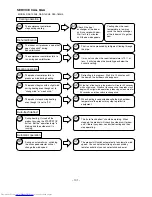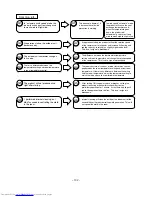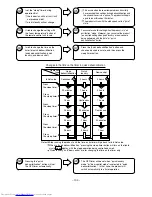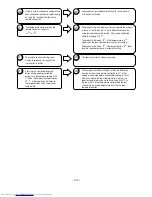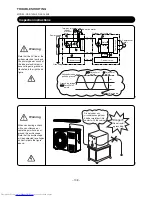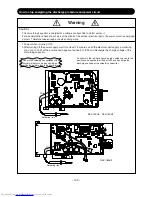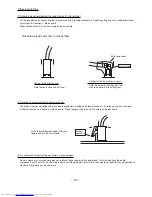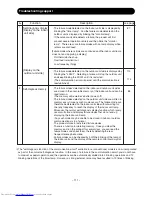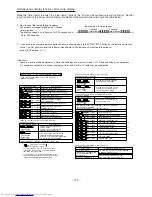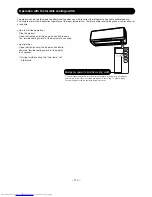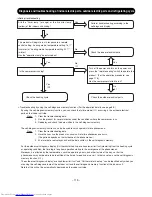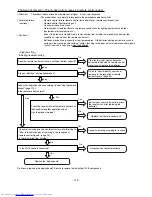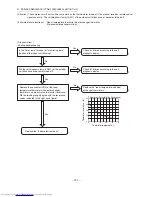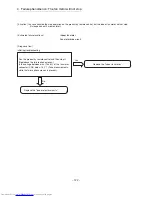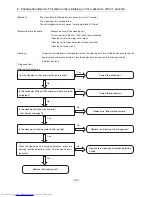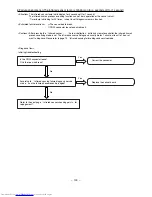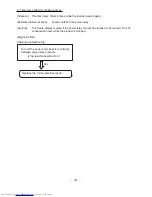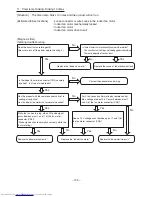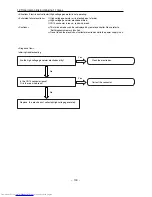
< Troubleshooting by using the self-diagnosis memory function>(For the operation details, see page 88. )
・
By using the self-diagnosis memory function, you can check the failure mode (
※
1) occurring in the outdoor electrical
parts on the indoor unit side.
Steps
1. Clear the troubleshooting data.
2. Run the product for several minutes under the conditions where the compressor runs.
3. Redisplay and check the data written in the self-diagnosis memory.
・
The self-diagnosis memory function can also be used to catch sporadic failure phenomena.
Steps
1. Clear the troubleshooting data.
2. Have the user use the product as usual until a failure phenomenon occurs.
(The period depends on the incidence of the phenomenon.)
3. At a later date, redisplay and check the data written in the self-diagnosis memory.
・
For the outdoor self-diagnosis display (OH thermistor heat-up, overload lower limit cut) stemming from the freezing cycle
or operating condition, the time lag is long from operation startup to the emergence of the phenomenon.
Moreover, it is affected by the temperature, sunshine, operating hours, and other factors of the day, so that the
phenomenon may not be able to be identified at the time of a repair service visit. In that case too, use the self-diagnosis
memory function (
※
2).
・
The outdoor self-diagnosis display "overload lower limit cut" and "OH thermistor heat-up" can be identified only when you
are using the self-diagnosis lamp of the outdoor unit and the self-diagnosis memory function of the indoor unit.
Note that this will not be automatically displayed on the indoor unit side.
Initiating troubleshooting
Yes
Perform troubleshooting according to the
self-diagnosis display.
No
No
No
No
※1
※1
※2
Are the "timer lamp" (orange) or the "monitor lamp"
(yellow) of the indoor unit blinking?
The product will begin to run in response to a remote
control setting: "cooling mode, temperature setting 16
℃
"
(summer) or "heating mode, temperature setting 32
℃
"
(winter).
Has the "operation lamp" been turned on?
Yes
Yes
Yes
Check the indoor electrical parts.
Is the compressor running?
Turn off the power and turn on the power and
press the "forcible cooling" switch to operate the
product. (For the operation procedure, see
page 116.)
Has the compressor started to run?
Check the freezing cycle.
Check the outdoor electrical parts.
– 115 –
Diagnosis and troubleshooting of indoor electric parts, outdoor electric parts and refrigerating cycle
Summary of Contents for RAC-10SH3
Page 57: ... 55 MODEL RAC 18SH3 Unit mm 580 5 600 345 299 19 5 ...
Page 60: ... 8 5 WIRING DIAGRAM MODEL RAS 10SH3 3 H S 4 1 S A R 3 H S 8 1 S A R INDOOR UNIT ...
Page 62: ... 0 6 MODEL RAC 18SH3 OUTDOOR UNIT WHT YEL RED INDOOR UNIT ...
Page 64: ... 2 6 3 H S 8 1 S A R 3 H S 4 1 S A R 3 H S 0 1 S A R L E D O M ...
Page 150: ... 8 4 1 MODEL RAC 18SH3 ...
Page 153: ...HHAW NO 0060E RAS 10SH3 RAC 10SH3 RAS 14SH3 RAC 10SH3 RAS 18SH3 RAC 18SH3 ...

